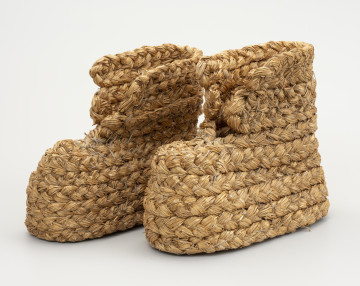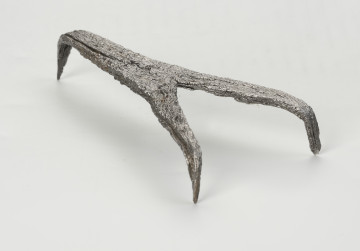
Pair of straw boots (berloce)
1900 — 1950
National Museum in Szczecin
Part of the collection: Basketry
Boots made of straw were not used for walking. They were worn to protect the feet from the cold during winter farm work and sleigh travel. They were particularly useful during threshing with the flail, which took place on the barn's threshing floor almost every day, as long as there was grain to thresh. Usually, two working men were able to thresh 35-37 kg of grain in one day. The threshing men would get hot with the hard physical work, but their feet, kept immobile, would get cold. Straw shoes, often still lined with hay inside, served as an excellent insulator against the cold. Straw braids, which were not very complicated to make, were used to manufacture simple products in every household. They included straw mats, plaits for sealing doors and windows, shoes, and straw skeps. Specialised straw weaving skills were required to make hats, decorative boxes, plates, and bags. Regardless of the product type, straw was prepared in the same way. After cutting, when the rye was still slightly green, it had to be bleached in the sun, cleaned of leaves and nodes, cut, and sorted. Once prepared this way, the product straw was durable and long-lasting. For, if it was cut down, once the grain had formed in the ear, the straw became broad, brittle and fragile. Iwona Karwowska
Author / creator
Object type
berloce straw boots
Technique
coiling (weaving), braided weave
Material
straw, plant-based string
Origin / acquisition method
donation
Creation time / dating
Creation / finding place
Owner
Muzeum Narodowe w Szczecinie
Identification number
Location / status

1900 — 1950
National Museum in Szczecin

700 — 1250
National Museum in Szczecin

circa 1990 — 2000
National Museum in Szczecin
DISCOVER this TOPIC
Museum of King Jan III's Palace at Wilanów
DISCOVER this PATH
Educational path